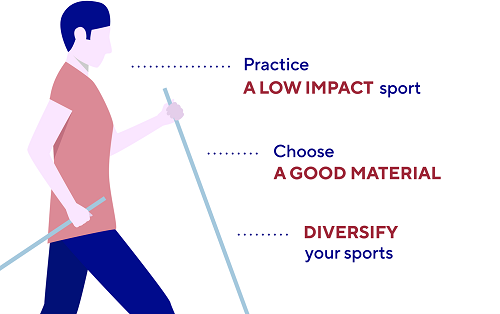Osteoarthritis of the knee: which sports are best?

You have osteoarthritis of the knee and would like to start, continue or resume a sports activity... but you are worried about being limited by your condition? While enjoyment should be the main factor guiding your choice, opting for a suitable activity will allow you to get the best out of your sport, while at the same time sparing your joints!
The treatment of osteoarthritis of the knee (or gonarthrosis) is largely based on targeted exercises designed to strengthen muscles and improve flexibility, along with moderate endurance activities, such as walking. Carried out up to three times a week, this has demonstrated benefits on mobility, pain and general health(1). But, in addition to these structured therapeutic activities, what about “real” sports when you suffer from osteoarthritis of the knee?
Low or moderate-impact sports, involving little strain and few twisting movements, are recommended for patients with osteoarthritis of the knee(1). However, it’s important to remember that the degree of severity of the arthritis will have a bearing on someone’s ability to take part in sports: very severe OA causes pain, stiffness and swelling and therefore limits the majority of sports activities.
Your doctor (possibly accompanied by other specialists) will guide you in the choice of your sports activities, depending on your medical circumstances, your age and your preferences. They will help you put together a programme taking into account the limitations identified and your own particular objectives.
We now know that sports involving repeated impacts or shocks or significant stresses on the knee, in either aligned or twisted positions, increase the risk of osteoarthritis(1). They may also increase the risk of development of symptoms in people who are already affected. Various studies have shown, for example, that some sports are very hard on the knees: football, basketball, handball, rugby, judo, wrestling, weightlifting, racket sports (tennis, squash), water-skiing, professional dancing and intensive or competitive long-distance running(1).
The risk is increased:
• if these sports are carried out in addition to a job that is physically demanding on the knees
• in the event of poor alignment of knees, muscle weakness or overweight.
However, sports that improve muscle function while avoiding peaks of stress on the joints help stabilise the latter. Sports meeting these criteria and recommended for sufferers of osteoarthritis of the knee are low-impact sports, such as cycling on comfortable terrains, Nordic walking, cross-country skiing or easy downhill skiing, swimming or diving(1).
A person with osteoarthritis of the knee who is continuing or resuming a sports activity will be less restricted and have less risk of joint injuries than someone starting a new sport. This is because residual pre-existing muscle strength and a good command of the sport’s technical skills will reduce the risk of injury and pain.
But regardless of your level, it is important to use high-quality equipment that absorbs and protects against shocks. It is obviously essential to choose the right footwear for the sport. In some cases, the use of suitable knee braces may be indicated. It may also be useful to think about the most appropriate training surface. In addition, alternating different sports helps reduce repeated strain on the joints(1).
To conclude, one last piece of common-sense advice: whatever the sport, if it causes significant pain, you should give it up. Why not try a different activity (with the guidance of a doctor or physiotherapist)?
If you have any questions, ask your doctor for advice.